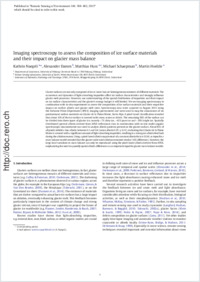Imaging spectroscopy to assess the composition of ice surface materials and their impact on glacier mass balance
- Naegeli, Kathrin Department of Geosciences, University of Fribourg, Switzerland
- Damm, Alexander Remote Sensing Laboratories, University of Zurich, Switzerland
- Huss, Matthias Department of Geosciences, University of Fribourg, Switzerland - Laboratory of Hydraulics, Hydrology and Glaciology (VAW), ETH Zurich, Switzerland
- Schaepman, Michael Remote Sensing Laboratories, University of Zurich, Switzerland
- Hoelzle, Martin Department of Geosciences, University of Fribourg, Switzerland
-
03.08.2015
Published in:
- Remote Sensing of Environment. - 2015, vol. 168, p. 388–402
Glacier
Albedo
Light absorbing impurities
Mass balance modelling
Imaging spectroscopy
Remote sensing
APEX
English
Glacier surfaces are not only composed of ice or snow but are heterogeneous mixtures of different materials. The occurrence and dynamics of light-absorbing impurities affect ice surface characteristics and strongly influence glacier melt processes. However, our understanding of the spatial distribution of impurities and their impact on ice surface characteristics and the glacier's energy budget is still limited. We use imaging spectroscopy in combination with in-situ experiments to assess the composition of ice surface materials and their respective impact on surface albedo and glacier melt rates. Spectroscopy data were acquired in August 2013 using the Airborne Prism EXperiment (APEX) imaging spectrometer and were used to map the abundances of six predominant surface materials on Glacier de la Plaine Morte, Swiss Alps. A pixel-based classification revealed that about 10% of the ice surface is covered with snow, water or debris. The remaining 90% of the surface can be divided into three types of glacier ice, namely ~ 7% dirty ice, ~ 43% pure ice and ~ 39% bright ice. Spatially distributed spectral albedo derived from APEX reflectance data in combination with in-situ multi-angular spectroscopic measurements was used to analyse albedo patterns present on the glacier surface. About 85% of all pixels exhibit a low albedo between 0.1 and 0.4 (mean albedo 0.29 ± 0.12), indicating that Glacier de la Plaine Morte is covered with a significant amount of light-absorbing impurities, resulting in a strong ice-albedo feedback during the ablation season. Using a pixel-based albedo map instead of a constant albedo for ice (0.34) as input for a mass balance model revealed that the glacier-wide total ablation remained similar (10% difference). However, the large local variations in mass balance can only be reproduced using the pixel-based albedo derived from APEX, emphasizing the need to quantify spatial albedo differences as an important input for glacier mass balance models.
- Faculty
- Faculté des sciences et de médecine
- Department
- Département de Géosciences
- Language
-
- English
- Classification
- Hydrology
- License
- License undefined
- Identifiers
-
- RERO DOC 258347
- DOI 10.1016/j.rse.2015.07.006
- Persistent URL
- https://folia.unifr.ch/unifr/documents/304760
Statistics
Document views: 100
File downloads:
- hoe_isa.pdf: 238
